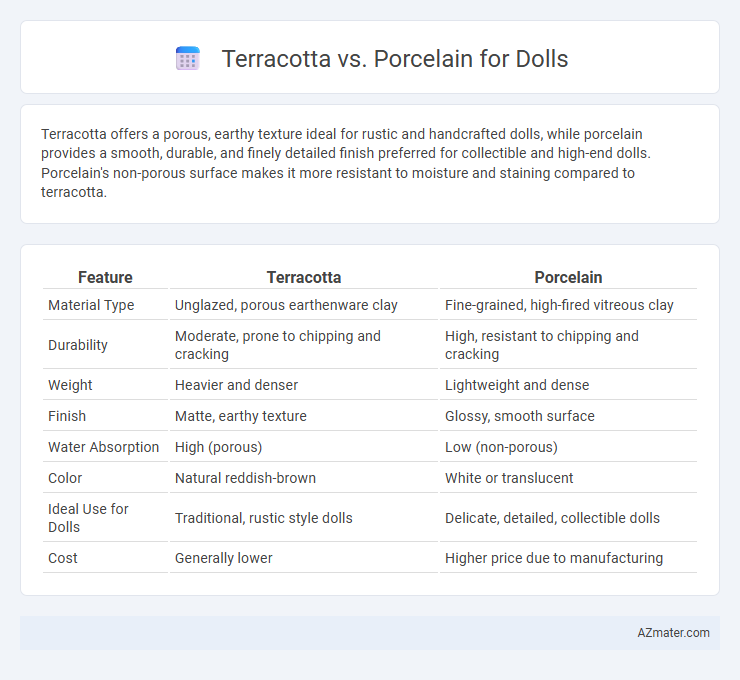Terracotta offers a porous, earthy texture ideal for rustic and handcrafted dolls, while porcelain provides a smooth, durable, and finely detailed finish preferred for collectible and high-end dolls. Porcelain's non-porous surface makes it more resistant to moisture and staining compared to terracotta.
Table of Comparison
| Feature | Terracotta | Porcelain |
|---|---|---|
| Material Type | Unglazed, porous earthenware clay | Fine-grained, high-fired vitreous clay |
| Durability | Moderate, prone to chipping and cracking | High, resistant to chipping and cracking |
| Weight | Heavier and denser | Lightweight and dense |
| Finish | Matte, earthy texture | Glossy, smooth surface |
| Water Absorption | High (porous) | Low (non-porous) |
| Color | Natural reddish-brown | White or translucent |
| Ideal Use for Dolls | Traditional, rustic style dolls | Delicate, detailed, collectible dolls |
| Cost | Generally lower | Higher price due to manufacturing |
Introduction to Terracotta and Porcelain Dolls
Terracotta dolls are crafted from natural clay, distinguished by their porous texture and warm, earthy tones that give each piece a unique, handmade appeal. Porcelain dolls, made from finely-powdered white clay fired at high temperatures, offer a smooth, glossy finish with delicate, refined features prized by collectors and artisans. Both materials provide distinct aesthetic qualities and durability levels, making them popular choices for doll making and collecting.
Historical Background of Terracotta and Porcelain Dolls
Terracotta dolls trace back to ancient civilizations such as Mesopotamia and the Indus Valley, where artisans crafted figurines from baked clay, embodying cultural symbolism and everyday life. Porcelain dolls emerged in 18th-century Europe, particularly Germany and France, with refined manufacturing techniques that produced delicate, lifelike figures valued for their artistic detail. The historical evolution of terracotta and porcelain dolls reflects distinct regional craftsmanship and technological advancements influencing doll-making traditions.
Material Composition: Terracotta vs Porcelain
Terracotta is a porous clay material composed primarily of natural iron-rich clay fired at lower temperatures, giving it a rustic, matte finish ideal for handcrafted doll bodies. Porcelain, made from refined kaolin clay and fired at very high temperatures, results in a dense, non-porous ceramic with a smooth, glossy surface perfect for detailed, delicate doll features. The key difference lies in terracotta's porous, earthy texture versus porcelain's hard, translucent quality, influencing durability and aesthetic appeal in doll making.
Manufacturing Process Comparison
Terracotta dolls are crafted by shaping natural clay and firing it at lower temperatures, typically between 1000 and 1150degC, resulting in a porous and earthy texture. Porcelain dolls undergo a refined process involving finely ground white clay and kaolin, fired at much higher temperatures around 1200 to 1400degC, which creates a dense, translucent, and smooth finish. The higher firing temperature and material composition in porcelain manufacturing yield a more durable and delicate doll compared to the rustic and fragile nature of terracotta dolls.
Visual Appearance and Finish
Terracotta dolls exhibit a warm, earthy tone with a matte, slightly rough texture that highlights handcrafted details and natural imperfections. Porcelain dolls offer a smooth, glossy finish with a refined, polished surface that enhances delicate facial features and provides a lifelike, translucent quality. The visual appeal of terracotta emphasizes rustic charm, while porcelain delivers elegance and intricate precision in doll craftsmanship.
Durability and Longevity
Terracotta dolls are more fragile due to their porous nature, making them prone to chipping and cracking over time, especially when exposed to moisture. Porcelain dolls offer superior durability and longevity, as the vitrified surface resists moisture absorption and physical damage, preserving intricate details longer. Collectors often prefer porcelain for its ability to endure handling and environmental factors without significant degradation.
Collectibility and Value
Terracotta dolls, prized for their rustic charm and historical significance, often carry a higher collectible value due to their rarity and handcrafted nature. Porcelain dolls, known for their delicate finish and detailed facial features, maintain steady demand among collectors seeking fine craftsmanship and preservation potential. Market trends indicate porcelain dolls from renowned manufacturers typically appreciate faster, while authentic antique terracotta dolls hold significant cultural value that can drive auction prices.
Artistic Detailing and Realism
Terracotta dolls exhibit a warm, earthy texture that enhances artistic detailing by allowing intricate hand-carved features and natural color variations, contributing to a rustic realism. Porcelain dolls offer smoother, finer surfaces ideal for precise, delicate facial expressions and lifelike skin tones, achieving high realism with painted details and glazing. Both materials support detailed craftsmanship, but porcelain excels in creating polished, realistic finishes while terracotta emphasizes organic, tactile artistry.
Care and Maintenance Requirements
Terracotta dolls require gentle handling and regular sealing with a breathable sealant to prevent moisture absorption and cracking, while porcelain dolls need careful dusting and occasional polishing to maintain their smooth, glossy finish. Avoid exposure to extreme temperatures or direct sunlight for both materials to preserve color and structural integrity. Proper storage in a padded, temperature-controlled environment minimizes the risk of chipping or breakage for terracotta and porcelain dolls alike.
Choosing Between Terracotta and Porcelain for Your Collection
Terracotta offers a rustic, earthy texture and warm tones, ideal for collectors valuing traditional craftsmanship and a natural aesthetic. Porcelain, known for its smooth, glossy finish and fine detail, suits those seeking durability and a refined, delicate look for their doll collection. Selecting between terracotta and porcelain depends on your preference for either the sturdy, organic charm of terracotta or the polished, elegant appeal of porcelain dolls.

Infographic: Terracotta vs Porcelain for Doll
 azmater.com
azmater.com